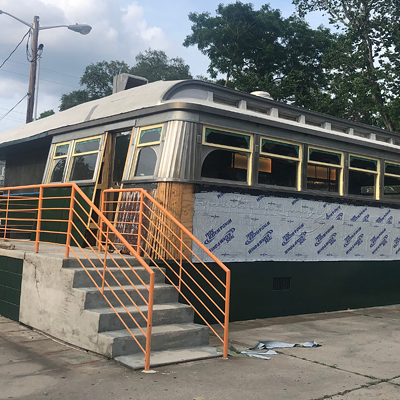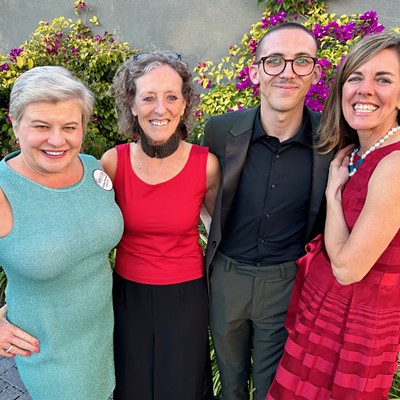COMING ACROSS the Talmadge Bridge from South Carolina is the best way to view Savannah’s urban forest. A mass of green covers the city, with only the tallest buildings poking through the trees. Preservationists want to keep it that way, while developers say the city’s current height restrictions on new construction create unfair hurdles for development.
Recent developments are just the latest in a long battle between the two camps. The whole issue literally dates back to 1733, when Gen. James Oglethorpe’s city plan was put into action.
Oglethorpe’s visionary plan was different from those of previous colonial towns because of its repeated pattern of connected neighborhoods, or wards. These neighborhoods were formed around squares that allowed for more open space in Savannah than in any city layout in history.
This plan reduces the scale of the city to a human level, with few buildings taller than five stories, which adds to the city’s historic charm and beauty. The very ground underneath also restricts the building of skyscrapers because it’s made up of sand.
The Historic District Height Development Map was created in 1996 as one section of a broader manual that regulates just about everything in Historic District buildings. That manual was developed by Christopher Chadbourne, a preservation consultant in Cambridge, Mass.
Changes were made to the original document in 2003, but only after two years of intense work by the Metropolitan Planning Commission. Those changes restricted the tallest buildings to the area of Johnson Square, with all other buildings stepping down in size to make them more compatible with residential areas.
Back then, those changes didn’t come about without controversy. Developers opposed the lowering of maximum heights, and were granted concessions, to the dismay of preservationists.
The most recent controversy centers around a proposed five-story condominium building that would be built on West Liberty Street where a former auto parts store now stands. Nearby residents and preservationists think the building would dwarf other structures in the area, even though it meets the Historic Review Board’s 11 factors of visual compatibility, including the height requirement that must be considered when proposing a new building.
Despite concerns by preservationists, the city council approved the project. In response, the Beehive Foundation, the Historic Savannah Foundation and the Downtown Neighborhood Association filed suit against the city, claiming the height map was improperly adopted in 2003 because the council never sent changes in the ordinance back to the MPC.
Chatham County Superior Court Judge Perry Brannen sided with the preservationists by removing language from the ordinance that states developers “shall” be able to build to the limits of the height map. He ruled that the council illegally adopted the language of the amendment in 2003.
The sentence in question reads: “Maximum heights on the height map shall be permitted.” City officials say that sentence clarifies the ordinance, but opponents says it opens the door to unbridled and uncontrollable development.
The resulting triangle consisting of city officials, developers and preservationists was already locked in a dispute when the MPC endorsed the height map amendment on Nov. 6, bucking public opposition. As a result, more than 100 people turned out at a Nov. 8 city council public hearing to express their concerns.
Earlier in the day, council members took part in a workshop concerning the issue. Following the public hearing, they tabled the matter, saying more time is needed.
“I am pleased that our council does seem to be listening to our concerns, but we have more work to do to get across our observations about what’s happening to our Landmark District,” Historic Savannah Foundation Executive Director Mark C. McDonald said the following day in a letter to supporters.
“It seems they hear in detail each time a developer does not get his way but we don’t communicate enough about the overwhelming majority of times that our review board passes these incompatible big projects,” McDonald wrote. “We do not have any idea when they will vote on the ordinance but will of course be scrutinizing the council agenda intensely.”
Mayor Otis Johnson, just re-elected two days before, pointed out that the present council is not responsible for actions by the previous council. “Five of the members of the present council were not on the council in 2003,” he said. “Any animus should be direct towards that council and not us.”
Attorney Owen Murphy represents the Beehive Foundation. “It’s about due process,” he said.
Murphy says the public should have been able to review the text amendment. “Those rules were not followed,” he said. “That language was added at the last minute. The MPC and members of the public didn’t realize that sentence had been added.”
McDonald said the issue affects the entire landmark district, not must one part of it. “The Historic Savannah Foundation believes very much that downtown residents deserve predictability, too. The Historic Savannah Foundation is communicating with developers to work as part of a team to come up with language to provide a sense of predictability,” he said.
“It’s a scary thing to have a vacant lot in a downtown neighborhood, especially in this building climate,” McDonald said. “We are completely opposed to the current proposal.”
The West Liberty project is inappropriate for its proposed location, McDonald said. “There is a lot of feeling that the building is out of scale,” he said. “It was turned down by the review board. There was an attempt to scale it down, but it wasn’t possible.”
Developer Michael Brown also opposes the amendment. “Restraint equals value,” he said, referring to South Beach, Key West and other historic cities that have been adversely affected by sprawling development.
“The entire community is opposed to this,” Brown said, and pointed to the Columbia Square condominium development on State Street as an example of an over-scale building constructed in the historic district.
Longtime preservationist Emma Adler asked the council to proceed slowly. “I know we all care. Every single person in this room cares,” she said.
“We have something that is very, very precious. I know we all want to protect it. Long ago, in the late 60s, during more innocent times, everyone was trying to do the right thing,” she continued.
“Our historic buildings -- we only have so many of them,” Adler said. “We must be very careful about new buildings. This is a living city, so it’s not necessary to build copies of 18th and 19th century buildings, as long as they are the right scale and the right materials. To build to height without regard to what is next door is just not the wise thing to do.”
The mayor agreed that the issue is particularly sensitive. “The MPC has been given a hot potato,” he said. “We’re going to deal with it. Probably in the end, some of you are going to be happy, and some are going to be unhappy. But it will be resolved.”
Helen Downing pointed to previous projects that ended up causing more harm than good -- the destruction of the City Market for a parking garage, the demolition of historic houses for the civic center and the division of entire neighborhoods for Interstate 16.
“Think about some things that were done in the past by very well meaning people in the interest of progress,” Downing said. “There are things that were done in the past that we wish now hadn’t been done.”
Proponents for the developers also were present, including Jeff Notrica, who owns several parcels of land in the downtown area. “I was actually involved with the committee that developed the new height map in 2003,” he said.
“All the affected parties participated,” Notrica said. “I lost height on several parcels I owned, but we were promised that by doing so, we would end all controversy.”
Instead, even more controversy has been generated, Notrica says. “To resolve this issue is a challenge, to say the least,” he says.
Notrica said that the historic Derenne Apartments could not have been built if the current restriction had been in place in 1924. “Height is not the issue,” Notrica concluded. “It’s more of a design issue and people are confusing height with design. That is an affront.”
Attorney Jonathan Hart represents Julius Bennett, developer of the West Liberty Street condominium project. “This man came here and knew we had an ordinance,” Hart said. “He read it and thought he knew what it meant. It’s been on the books for four years. If we’re going to have a viable downtown, we’re going to need space for everyone. I don’t think those people are going to want to see three-story buildings.”
Hart said Bennett agreed to decrease his building plans to four and a half stories. “It seems like a good compromise to me,” Hart said.
W. John Mitchell, president of the Historic Savannah Foundation Board, said the issue is an emotional one for many people. “There’s a lot of passion surrounding this issue,” he said.
Mitchell said he was aware that the council had been the butt of many negative comments, but added he was certain its members could handle them.
“Hot potato?” he said. “You don’t need to handle a hot potato. You can hold on to it all you like.” 
To comment, e-mail is at






























